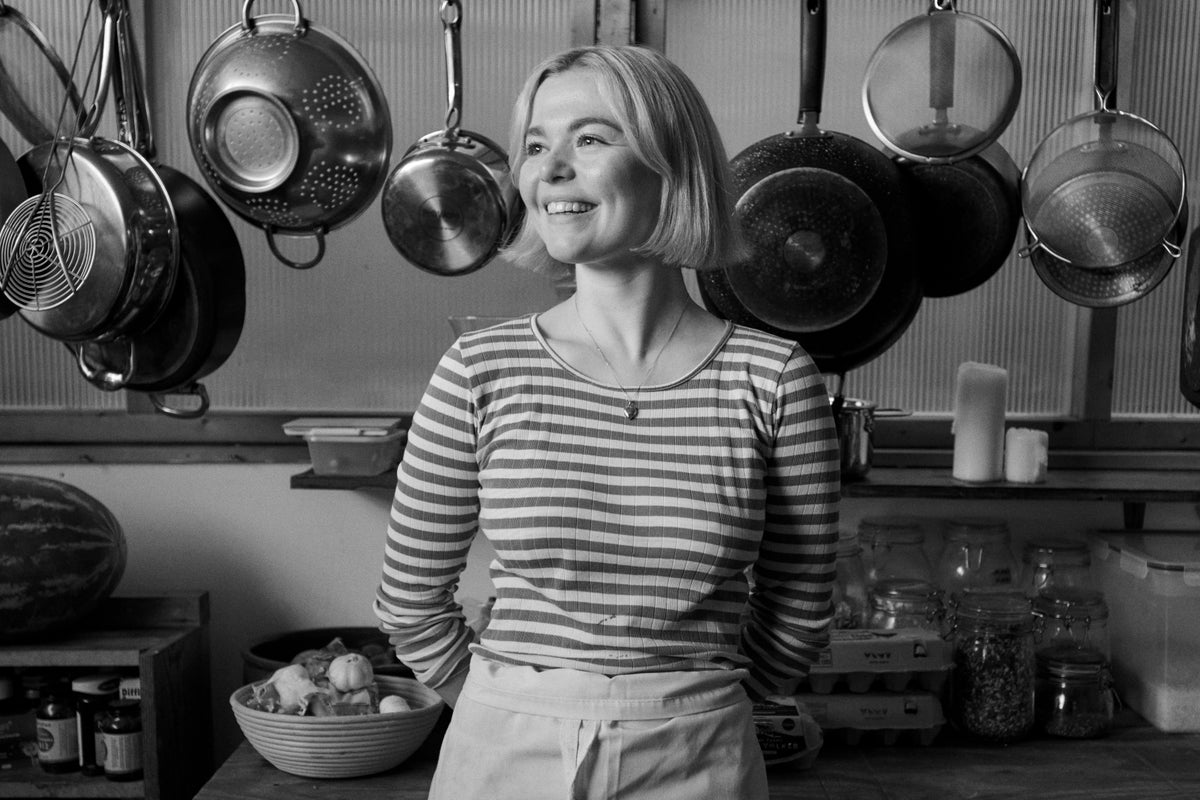How Rosie Kellett turned a £25-a-week food budget into the dinner party dream

On any given evening in Rosie Kellett’s East London warehouse, you might find 10 housemates clustered around a battered kitchen table, passing plates of chickpea stew, candles flickering in jam jars, a record playing somewhere in the background. If you’re lucky, there’ll be a “late plate” in the fridge – a silent promise that whatever the night holds, a hot dinner with your name on it will be waiting when you get home. It sounds like the sort of communal living that might briefly flourish in a university flatshare. But here, it’s different. The house runs on a shared kitty, a cooking rota and an unspoken philosophy of looking after each other – a model that has quietly become a blueprint for how young adults can still carve out an affordable, joyful life in a city that seems increasingly hostile to both. “I moved into the warehouse at a really chaotic time in my life,” Kellett says. “I was fresh out of a pretty bad break up and had been looking for somewhere to live for months. I was close to giving up and felt like a room in a warehouse was a last resort.” She didn’t expect to find a home. Then she met her housemates – 10 strangers who, instead of exchanging awkward pleasantries, grilled her around the communal table about her cooking skills. “It was intimidating to say the least, but as they explained their communal way of living, cooking for each other, sharing responsibilities and food, my ears pricked up,” she recalls. “To know that my living expenses for the month would be just £100, with all my food, toiletries, cleaning materials taken care of, was a deep comfort and relief.” It wasn’t just the financial balm she needed. Living communally, Kellett says, “has been the single most positive decision I’ve made in the last decade, and without it, I don’t know if I would still be living in the city.” Today, Kellett is a food writer, supper club host and the author of In for Dinner – a new cookbook that celebrates exactly this kind of communal, comforting, low-fuss eating. She’s also built a substantial following on Instagram (303,000 and counting), where she shares crowd-pleasing recipes, hosting guides and glimpses of her day-to-day warehouse life. A recent appearance on Channel 4’s Sunday Brunch marked another unexpected milestone in a journey that began, improbably enough, with a career in acting. Cooking for a crowd was never part of the plan – but somewhere between the late plates, chickpea stews and dumpling feasts, it became a calling. A typical night at the warehouse might involve Pier’s fiery curry, Virginia’s bean stews, or Wojciech’s pantry pasta (“the best I have ever eaten and I look forward to it all week,” says Kellett). “Dinner is a pretty relaxed affair, I like to light candles whatever the occasion and put some good music on,” she says. Sometimes, the cook for the night will start alone; other times, the kitchen fills up with chatter, small jobs being done, beers cracked open. Legendary meals are not in short supply. One that stands out is pierogi night, which began when friends from Poland came to stay. “To say thank you to the warehouse for having them, they cooked up a huge pierogi feast,” Kellett remembers. “Starting in the morning, with one of their mums giving advice on FaceTime, they made the dough and filling, then spent all afternoon shaping the dumplings. I think they ended up making just over 200 pierogi. Our kitchen table was covered in perfect little stuffed dumplings!” When dinner came, they boiled them all and then fried them in butter until golden. “We ate the pierogi with caramelised onions, sour cream, sauerkraut and fresh chives,” she says. “I don't think I have ever eaten that many dumplings in one sitting before and I'm not sure I will again.” Kellett helped cook, and the night left such a mark that she developed a recipe inspired by it for In for Dinner. Given the choice, Kellett says, she would always choose to stay home and cook. Not out of duty, but because, for her, the act of turning a few humble ingredients into a meal for loved ones is still “magic”. “I get a lot of joy from taking a simple group of ingredients and transforming them into a delicious meal and THEN getting to feed that meal to the people I love,” she says. “The whole experience still feels like magic to me and is deeply therapeutic.” "Nothing is more satisfying to me than pulling together a meal from what is left in the fridge or the cupboards, transforming a few unassuming ingredients into a meal," she adds. That “first part” – choosing ingredients, designing a meal and bringing it to life – is what she misses when dining out. And it seems she’s not alone. Kellett sees a broader trend unfolding: a move away from splashy restaurants and towards slow, intentional meals at home. “You could spend £20 and a few hours in the kitchen cooking a meal for six and then sit for hours around your kitchen table catching up at your own pace, vs going to a restaurant where you’ll spend double per head and have to give the table back after two hours,” she says. It’s not that she doesn’t value restaurants. Quite the opposite. “Now more than ever the hospitality industry needs our support as they are facing rising costs and miniscule margins at every corner, not to mention a staffing crisis,” she says. But for many, the financial reality is impossible to ignore. As Kellett puts it: “The cost of living crisis has left us all with far less disposable income and where it might have been possible to eat out a couple times a week a few years ago, it may only be possible a few times a month now.” One of the most jaw-dropping aspects of Kellett’s warehouse life is the budget: £25 a week, per person, for food. That’s £150 total – covering seven nights of dinners for six, plus extras. It works out to a few pounds per meal, and even less if you factor in lunch leftovers. It helps that the house leans on hearty, affordable staples. “Beans are a great budget friendly option to build a meal around, same with tinned fish, preserved ingredients in jars – basically all the pantry staples!” she says. A favourite crowd-pleaser? Her confit tomato and chickpea stew. “For me, it’s always an absolute hit and ticks all the boxes for simplicity, budget, flavour and abundance,” she says. “It’s brilliant because there is barely any cooking: you put all the ingredients into an ovenproof pot, give it a stir and then whack it in the oven for three hours, that’s literally it.” The resulting dish is vegan, gluten-free, “super affordable” and a good source of protein. Other warehouse hits on heavy rotation include her Sri Lankan dahl with coconut sambal (“cheap, super scalable, easy and caters to pretty much all dietaries”) and big-batch baked dishes that utilise the oven like spinach, ricotta and tomato lasagne or gnocchi alla Sorrentina. For those feeling daunted by the idea of feeding a crowd, Kellett’s advice is refreshingly straightforward: “Prep ahead, make something you know you can nail and ask for help.” She adds: “There is no prize for the most stressed chef or for the most difficult recipe attempted. I'm a big believer in a host really setting the tone for the evening, so if you’re relaxed, your guests will be too.” And don’t be precious about letting people pitch in. “Most people love to be given a little job in the kitchen and to feel useful, so involve your friends in those last touches and catch up while you’re at it.” Kellett’s approach to shopping is no-nonsense, too. Spend a little more where it matters – and know where you can save. “Olive oil is top of my list,” she says. “I use so much of it in my cooking and you can really taste, see and smell the difference between an extra virgin olive oil and a blend. It’s worth investing in the slightly more expensive choice; the difference in taste and quality is like night and day.” The same goes for tinned tomatoes (“the difference between the cheapest and the middle of the road options are vast”) and, if budget allows, jarred beans rather than tinned (“the texture and flavour are so much more delicious and can really transform a meal”). It’s a pragmatic philosophy rooted not in snobbery, but in squeezing the best out of your ingredients. Beyond budgets and recipes, Kellett sees something bigger at play. Communal living, she believes, offers not just a way to survive the financial squeeze, but a richer, more connected way of life. “I saw a very depressing headline the other day that said the perfect consumer is someone who lives alone,” she recalls. “It feels like late stage capitalism is pushing us all to have one of everything for ourselves, rather than sharing or spreading the load.” In a world that often champions individualism – one fridge, one olive oil bottle, one lonely shelf per person – her warehouse, then, feels like a quiet rebellion. “It’s getting harder and harder to live a good life in London (or any big city), but through building community, sharing resources, labour and responsibility, you can find the cracks of light.” Starting small, she insists, is the key. “If you live with housemates or friends, you could start a routine of cooking and sharing one meal a week together, maybe taking it in turns to cook,” she says. “If you are interested in sharing the cost of living but don’t want to go the whole hog, you could start a communal pot of money that pays for the weekly essentials like olive oil, salt, pepper, toothpaste, etc. “It always seemed mad to me that in a shared space everyone has their own bottle of olive oil, a shelf in the fridge and several duplicates of the same items being used at once!” Her message is simple: “Sharing is the backbone of communal living.” This recipe was born, like the best of them, out of necessity. While living with my first boyfriend in my early twenties, we existed almost exclusively off BLTs and a version of this pasta. Tinned fish and dried pasta were affordable, and this recipe became a staple dinner. It’s for the cash poor and the time poor, yet it’s serving big time flavour. It’s made up of pantry staples and will be on the table in less than half an hour. Ingredients: 200g stale bread 100ml extra virgin olive oil 1 clove of garlic, minced 500g dried spaghetti 4 × 125g tins of mackerel in olive oil, drained and broken up 1 × 180g jar of capers, drained and finely chopped 2 tsp chilli flakes Zest and juice of 3 lemons Large bunch of flat-leaf parsley, leaves and stalks finely chopped Sea salt and ground black pepper 1. First make the pangrattato by blitzing the bread into breadcrumbs in a food processor. 2. In a frying pan, over a medium heat, heat a tablespoon of the olive oil and fry the breadcrumbs with the garlic until golden brown and crisp. I like to take them pretty dark, bordering on a little burned, but you do you. 3. Cook the spaghetti in well-salted, boiling water until al dente. 4. Put the mackerel, capers, chilli flakes, lemon zest and juice, most of the parsley and half the olive oil into a large mixing bowl and combine thoroughly. 5. Drain the pasta, reserving a little of the water, and add it to the mackerel mixture. 6. Mix vigorously, adding a little pasta water and more olive oil if it seems too dry. You should end up with a glossy sauce that clings to the pasta. 7. Serve on a large platter, topped with the pangrattato and the rest of the chopped parsley. If you have made my pierogi recipe from the Dinner section of this book, you will know that it is a time-consuming, yet rewarding endeavour. I don’t always have the time to hand-make dumplings, but I often crave pierogi, and when I do, I make this soup. It has all the flavours of a pierogi but takes a fraction of the time and is delivered in a warming broth that feels more appropriate for lunchtime. Serves: 6-8 Ingredients: 1kg baby potatoes 3 tbsp butter 1 tbsp olive oil 3 large white onions, diced 1 tsp sea salt ½ tsp ground black pepper 1 litre vegetable stock 1 tbsp white wine vinegar 1 medium bunch of dill, roughly chopped 200g sauerkraut 150ml sour cream 1 medium bunch of chives, finely chopped 1. Boil the potatoes in well-salted water until tender, around 20 minutes depending on the size of your potatoes. They are cooked when a knife slips easily through them. 2. In a large heavy-bottomed pan over a medium heat, melt the butter with the olive oil and add the onions, salt and black pepper. 3. Cook the onions for at least 20 minutes and anywhere up to 40 minutes, so they get jammy and caramelised. 4. Remove a quarter of the onions from the pan and reserve them for topping later. 5. Add the stock, vinegar and all the potatoes to the pan. With a potato masher, or the back of a wooden spoon, break up the potatoes to release some of their fluffy interior – this will help to thicken up the soup. 6. Continue to simmer for 15 minutes, to allow some of the liquid to reduce and thicken. 7. Stir in all the chopped dill and half the sauerkraut. 8. Serve in bowls, topped with a dollop of sour cream, a sprinkle of chives, the rest of the sauerkraut, the reserved caramelised onions and more black pepper. Crunchy, chewy, salty, sweet, this cookie has it all. If you’ve never tried halva before, I highly recommend hunting it down – it’s a sweet sesame treat that’s sort of crumbly and soft in texture. When baked into this cookie it becomes a perfectly caramelised, nutty, chewy addition. You can find halva in most major supermarkets, but failing that, any Middle Eastern store will have it in abundance. These can also be cooked from frozen, and I always like to have a box in the freezer ready to go. Makes: 20 cookies Ingredients: 250g unsalted butter, softened 300g light brown sugar 200g halva, cubed (150g for the cookie mix, 50g for topping) 2 tsp vanilla bean paste 250g plain flour 1 tsp bicarbonate of soda 1 tsp sea salt, plus more for sprinkling 150g oats (100g blended into a ‘flour’, 50g left whole) 1 tbsp sesame seeds, plus more for rolling 100g good-quality dark chocolate, roughly chopped Stand mixer 1. In a stand mixer, beat together the butter and brown sugar until just combined. Add the egg, 150g of cubed halva and the vanilla and mix again until well combined, scraping down the sides of the bowl after each addition. 2. In a separate bowl combine the flour, bicarbonate of soda, salt, oats (both flour and whole), sesame seeds and chopped chocolate. 3. Add the dry ingredients to the wet and mix until a dough forms, then shape the cookies into 20 equal-sized balls, each weighing roughly 55g – I do this with an ice cream scoop so they are all the same size. 4. Roll each cookie ball in more sesame seeds. Using the remaining 50g of halva, press a piece of halva into the top of each cookie and put them on to a lined baking tray that fits into your freezer. 5. Freeze the shaped cookies for at least an hour, or until you are ready to bake. The cookies will last well in the freezer for up to 3 months like this. 6. When you are ready to bake, preheat the oven to 180C/160C fan/gas mark 4 and line a baking tray. Space the cookies out so they have enough room to double in size and sprinkle each one with a little flaky sea salt. 7. Bake for 12 minutes, then take the tray out and sharply tap it on a hard surface – this deflates the cookies and gives them a thin, crinkled texture. Put the tray back in the oven for a further 3 minutes. 8. Leave to cool completely on the tray, or until they are cool and firm enough to handle – there is nothing quite like a warm cookie fresh from the oven. Recipes from ‘In For Dinner’ by Rosie Kellett (Square Peg, £27.00).







![Man working in the US for 25 years finally goes to get his green card because he wants to do the right thing, gets detained by ICE [Interesting]](https://usrimg-full.fark.net/Z/ZH/fark_ZHXz-QhgUfbsprfAPqztXDcTvpw.jpg?AWSAccessKeyId=JO3ELGV4BGLFW7Y3EZXN&Expires=1746417600&Signature=sAiSqP%2FXlkooPWVJZT3cn3h1FW8%3D)










